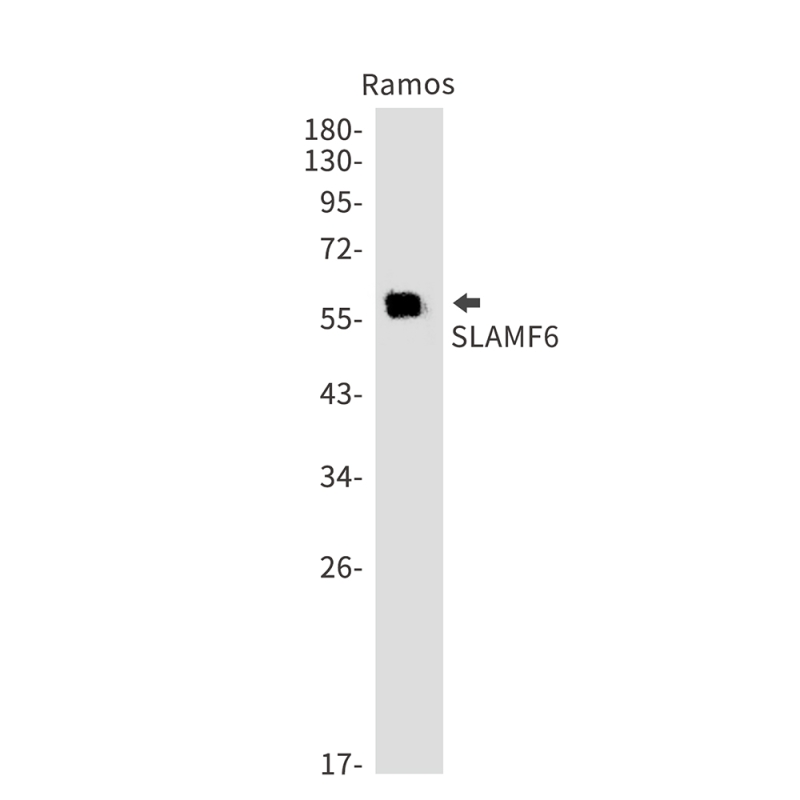
| WB | 1/500-1/1000 | Human,Mouse,Rat |
| IF | 1/20 | Human,Mouse,Rat |
| IHC | 咨询技术 | Human,Mouse,Rat |
| ICC | 1/50-1/200 | Human,Mouse,Rat |
| FCM | 咨询技术 | Human,Mouse,Rat |
| Elisa | 咨询技术 | Human,Mouse,Rat |
| Aliases | NTB-A; SLAMF6; Ly108; NK-T-B-antigen; CD352; KALI |
| Entrez GeneID | 114836 |
| WB Predicted band size | Calculated MW: 37 kDa; Observed MW: 60 kDa |
| Host/Isotype | Rabbit IgG |
| Antibody Type | Primary antibody |
| Storage | Store at 4°C short term. Aliquot and store at -20°C long term. Avoid freeze/thaw cycles. |
| Species Reactivity | Human |
| Immunogen | Recombinant protein of human SLAMF6 |
| Formulation | Purified antibody in TBS with 0.05% sodium azide,0.05%BSA and 50% glycerol. |
+ +
以下是关于SLAMF6抗体的3篇代表性文献及其摘要概述:
---
1. **文献名称**:*SLAMF6 as a Regulator of Exhausted CD8+ T Cells in Cancer*
**作者**:Freeman, C.M. et al.
**摘要**:该研究揭示了SLAMF6在肿瘤微环境中CD8+ T细胞耗竭中的作用。通过使用抗SLAMF6抗体阻断其信号通路,可逆转T细胞耗竭表型,并增强抗PD-1疗法的效果,为联合免疫治疗提供了新策略。
---
2. **文献名称**:*Targeting SLAMF6 in Multiple Myeloma: A Novel Immunotherapeutic Approach*
**作者**:Ponzetta, A. et al.
**摘要**:本研究开发了一种靶向SLAMF6的单克隆抗体,证明其在多发性骨髓瘤模型中可激活NK细胞和T细胞的抗肿瘤活性,并通过抑制肿瘤细胞免疫逃逸机制显著延长生存期。
---
3. **文献名称**:*SLAMF6 Antibody Modulates Autoimmune Responses in Lupus-Prone Mice*
**作者**:Li, Y. et al.
**摘要**:研究发现SLAMF6抗体在系统性红斑狼疮(SLE)小鼠模型中能调节T-B细胞相互作用,减少自身抗体产生,并缓解肾脏病理损伤,提示其作为自身免疫疾病治疗靶点的潜力。
---
这些文献涵盖了SLAMF6抗体在癌症免疫治疗、血液肿瘤及自身免疫病中的机制与应用研究。如需具体文章信息,建议通过PubMed或Web of Science按标题检索。
SLAMF6 (Signaling Lymphocytic Activation Molecule Family member 6), also known as CD352 or NTB-A, is a cell surface receptor belonging to the SLAM family of immune regulatory proteins. Expressed primarily on T cells, natural killer (NK) cells, and B cells, SLAMF6 plays a dual role in modulating immune responses. It functions as a self-ligand receptor, engaging in homophilic interactions to regulate cell activation, differentiation, and cytotoxicity. Structurally, it contains immunoglobulin-like domains in its extracellular region and cytoplasmic tails with conserved tyrosine-based signaling motifs that recruit adaptors like SAP (SLAM-associated protein) to mediate downstream signaling.
In immune homeostasis, SLAMF6 acts as a co-stimulatory or inhibitory receptor depending on context. It enhances NK cell-mediated cytotoxicity and T cell activation under certain conditions but can also suppress excessive immune responses to prevent autoimmunity. Dysregulation of SLAMF6 has been implicated in diseases such as cancer, chronic viral infections, and autoimmune disorders. For instance, in tumors, sustained SLAMF6 signaling may contribute to T cell exhaustion, while in autoimmune settings, altered expression correlates with aberrant lymphocyte activity.
SLAMF6-targeting antibodies are being explored therapeutically to either block inhibitory signals (e.g., enhancing anti-tumor immunity) or modulate hyperactive immune responses. Their development highlights SLAMF6's potential as a checkpoint molecule and biomarker in precision immunotherapy. Research continues to clarify its context-dependent mechanisms and optimize antibody-based interventions.
×